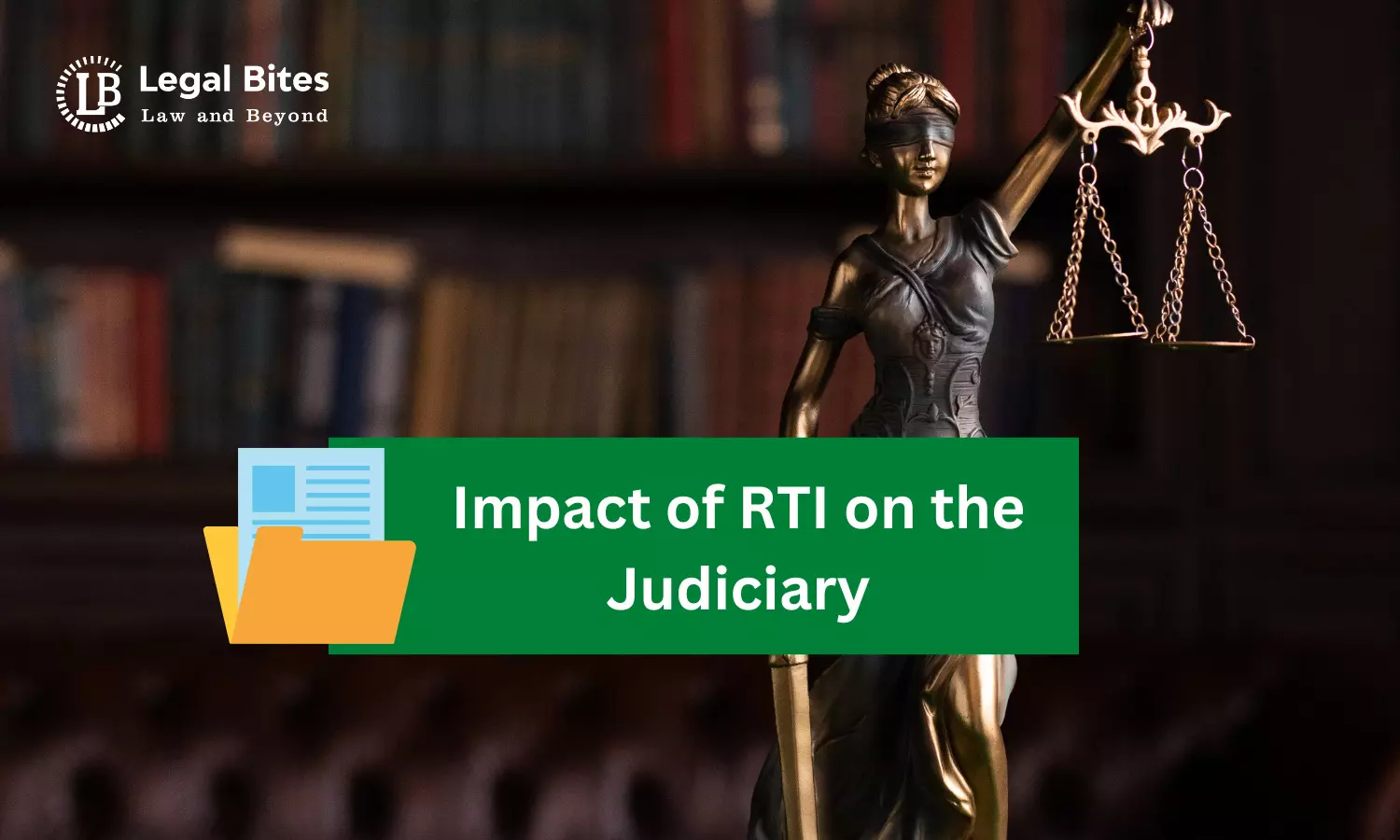Impact of RTI on the Judiciary
The article ‘Impact of RTI on the Judiciary' by Snehil Sharma intends to explore the juxtaposition of RTI and Judicial independence in the Indian Scenario.

The article 'Impact of RTI on the Judiciary' by Snehil Sharma intends to explore the juxtaposition of RTI and Judicial independence in the Indian Scenario. It will further discuss how the Judiciary has also acted as a backbone of RTI in the same scenario.
The Right to Information Act of 2005 was established as a basic right to make the disclosure of information by governmental entities mandatory. According to this law, a person can ask governmental agencies for the disclosure of certain information, and unless there are compelling legal arguments to the contrary, those agencies are required to provide the requested information in response. However, including the affairs of the Judiciary within the purview of RTI has been a matter of debate for a considerably long period of time.
Introduction
The Right to Information Act, 2005 (RTI Act), the country's first of its type sunshine law, was introduced intending to bring about a revolution in transparency. Through their rulings, courts all over the nation have played a significant role in promoting accountability and openness in the operations of public institutions. Ironically, the judiciary has also frequently disregarded the word and spirit of the RTI Act's regulations. For instance, The Supreme Court of India was directed by the Central Information Commission (CIC) in November 2009 to make information about the Collegium's decision-making public.
Subhash Chandra Agarwal, an activist, requested information under the RTI Act, which is the subject of the CIC order. The CIC specifically directed the Supreme Court's Central Public Information Office (CPIO) to make correspondence between the Collegium and the government on the appointment of Justices HL Dattu, AK Ganguly, and RM Lodha public.
These three judges were not as senior as Justices AP Shah, AK Patnaik, and VK Gupta at the time of their appointments. This was for the first time that the juxtaposition of RTI and the independence of the Judiciary got to light. However, The Supreme Court was of the view that the need for judicial independence does not stand in contradiction with that for transparency.
The state is comprised of the legislative, executive, and judicial branches. The RTI has always applied to the legislative and executive branches, but the inclusion of the judiciary has always been debatable due to its constitutionally guaranteed independence.
Indian Judiciary System
Indian judiciary is considered one of the oldest legal systems in the world. The striking parallels between the English and Indian legal systems show that it is a part of the paternity that India acquired from the British after more than 200 years of colonial control. The judiciary derives its power from the Indian Constitution, which established the framework for the new legal order.
The Indian Constitution is the supreme law and the source of all other laws in the nation. It not only established the framework for the Indian judicial system but also laid down the fundamental obligations, rules, and rights of the populace, which are now the responsibility of the Indian government. The body of the judiciary is unquestionably one of the most important institutions in a democratic society since it is tasked with the enormous responsibility of dispensing justice, which is one of a citizen's fundamental demands. The court is tasked with completely implementing the constitutional ideals to achieve the goals of the constitutional framers because it protects citizens' rights.
The principles of social, economic, and political justice for all of its people are enshrined in the Constitution's preamble. If justice is not applied in a reasonable manner, it endangers the rights of civil society and undermines the idea of the rule of law.
In order to ensure a system of justice in government and administration, the judiciary's position has been essential. Thus, judicial rulings in India have permeated every level of society, whether it be through the substantive understanding of Article 19 or Article 21, or by the preaching of the doctrines of equality. As everyone is aware, a robust democracy is built on a solid judiciary. It aspires to interpret the law creatively to meet the demands of society, rather than just following the black letter of the law.
Independence of judiciary
The framers of the Constitutional system recognized the importance of judges who can apply the law impartially and freely to the rule of law. On paper, the Constitution guarantees our rights, but it would be meaningless if there were no independent courts to uphold them. In order for the judiciary to fulfill its role as the Constitution's protector, independence is crucial. Justice can only be guaranteed to the people when the judiciary is apart from the executive and legislative branches of government.
Except in cases where specific remissionary powers are assigned to the executive heads, our Constitution guarantees the judiciary's complete independence. The term "judicial independence of the judiciary" refers to a situation in which judges can make decisions or render judgments without intervention from the executive branch or other powerful organizations.
Judicial independence is essential for maintaining the democratic system in every nation. It serves as a link between citizen protection against unconstitutional legislative and administrative powers. It is vitally important to be free from the executive's influence and authority. For the sake of individual freedom, it is crucial that judges provide their judgment without favoritism or fear. It alludes to a setting where the judge can make an objective decision.
Right to Information
One of the fundamental tenets of democracy is the right of every person to know the actual facts about the administration of their nation. People can only participate meaningfully in a democracy if there is an open government with full access to information about how the government functions. Without certain fundamental freedoms, such as the freedom of thinking, information, conscience, speech, expression, and movement, a citizen cannot acquire knowledge.
The Indian people pledged their determination to guarantee everyone's right to freedom of speech and thinking in the Preamble to the Constitution. Article (19) (1)(a) of Part III of the Constitution's list of Fundamental Rights expresses this resolution. The concept of "information freedom" is not mentioned in Article 19 of our Constitution, but the judiciary has ruled that it is covered in Article 19(1)(a), which protects freedom of speech and expression.
Judicial Interpretation of freedom of speech and expression
In a developing nation like India, where the majority of the population is uneducated, poor, and unaware of their rights, extracting information has been a difficult task. Red tape and bureaucratic dominance made it very difficult for poor people to exercise this power in earlier times. Additionally, the colonial legacy, which was heavily reliant on the secrecy policy, is still present in the system. The Indian Constitution steps in to protect the man in this situation by guaranteeing him a few basic rights. These rights, which take pride in our Constitution, reflect the fundamental values of existence in a civilized society.
Despite the advent of parliamentary democracy in India, there has been no legal right to information for many years. The Supreme Court through its vested power of interpretation held the right to information to be implied in the right to freedom of expression and speech by interpreting Article 19(1)(a) of the Constitution since our Constitution does not mention the term "freedom of information" in Article 19. It was the Indian judiciary that specifically considered the right to information as a natural concomitant of Article 19(1)(a) and Article 21 which includes rights such as the right to freedom of speech and expression and the right to life.
Landmark cases
The Central Public Information Officer, Supreme Court of India v. Subhash Chandra Agarwal, 2019 SCC OnLine SC 1459, is the most important case where the question was whether the judiciary's independence will suffer if the information kept by the CJI's office and collegium are made publicly available.
The Indian Supreme Court ruled in Hamdard Dawakhana v. Union of India, 1960 AIR 554, that Article 19(1)(a) of the Indian Constitution includes the right to information. Advertising is unquestionably a form of expression, but the object it is used to promote is where its true essence is revealed. It assumes the features and components of the operation in accordance with Article 19(1) which it seeks to assist by drawing the attention of the general public.
Another case of Romesh Thappar v. State of Madras, 1950 AIR 124, involved a petitioner's challenge of an order the then-Government of Madras had issued under Section 9(1-A) of the Madras Maintenance of Public Order Act, 1949, prohibiting the distribution of the petitioner's journal. Such a ban order was established as a violation of Article 19(1) right to freedom of speech and expression (a).
Supreme Court under RTI
The Supreme Court oversees the entire legal system of the nation as the highest court of law. All branches of government, including the legislative, executive branch, and judiciary, have been affected by the Right to Information Act of 2005. As may be seen from the pro-disclosure rulings that have come from higher courts as well as information commissions.
There is a growing understanding that having access to knowledge will benefit everyone in the long run. India's Right to Information can be viewed as having its foundation in the judiciary. The SC is crucial in defending the citizens' democratic rights, which are guaranteed by the constitution. The core of a democratic society is the administration of justice, which must be done without favouritism or fear.
Conclusion
A specific balance shall be established as to what shall be included within the purview of RTI so that it doesn't jeopardize the constitution's guarantee of judicial independence. Instead of being the supreme source of justice in the nation, if the judiciary will end up being used as a puppet by the populace, it will be potentially damaging to our nation. When Supreme Court rulings are contested, the constitution is always blamed. It should be made sure that evolving RTI shall not result in an extrajudicial burden over the functioning of the judiciary.
References
1. Vaidehi Misra, How India's Judiciary Is Curbing Citizens' Right to Information, Available Here
2. Rishab Pillai, Right to Information Act, 2005 (RTI) And Judicial Activism: Accountability and Independence Go Hand in Hand, Available Here
3. Nivrati Gupta, Balancing right to information with Indian Judiciary, Available Here
4. Prashant Reddy & Chitrakshi Jain, The Indian judiciary has declared war on the RTI Act – and that's hampering judicial reform, Available Here
5. Apoorva Mandhani, Judicial independence, motive & purpose, surveillance — how SC argues for and against RTI, Available Here
6. Tania Khurana, Transparency of Judiciary under Right to Information, Available Here
7. RTI and Judicial Independence, Available Here
Important Links
Law Library: Notes and Study Material for LLB, LLM, Judiciary, and Entrance Exams

